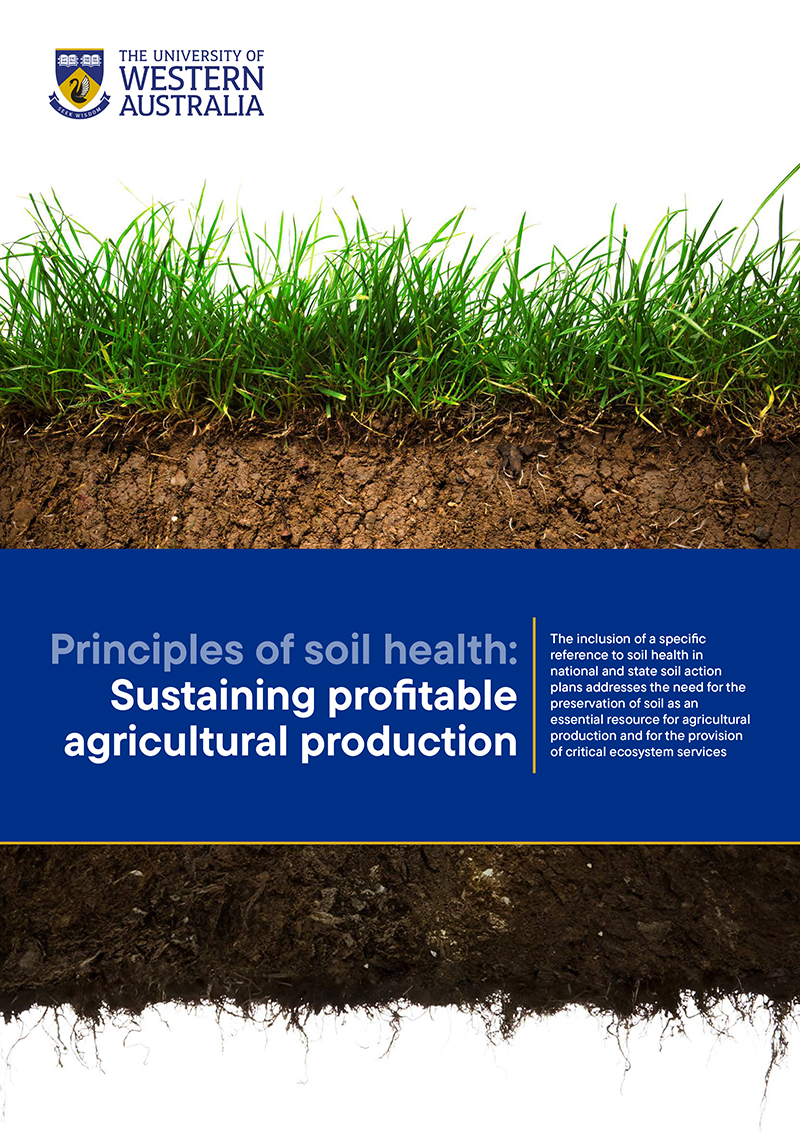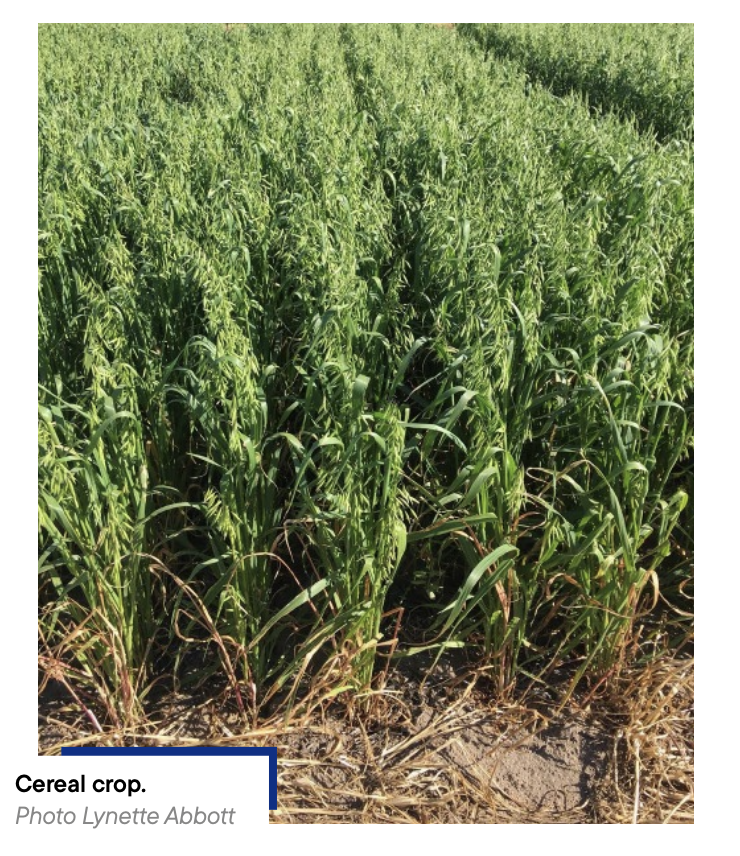The inclusion of a specific reference to soil health in national and state soil action plans addresses the need for the preservation of soil as an essential resource for agricultural production and for the provision of critical ecosystem services. Here, Lynette Abbott explores this topic further in her eBook;
The United Nations highlighted a significant global focus on ‘soil’ with the proclamation of the International Year of Soil in 2015, and the annual celebration of World Soil Day on 6th December.
Examples of these soil action plans are:
- Australia’s National Soil Action Plan (2023-2028)
- Western Australia’s Soil Health Strategy (2021-2031)
- USDA’s National Program 212 Soil and Air Action Plan (2021–2025)
- EU’s Soil strategy – European Commission (2030)
This article addresses a number of underlying principles of soil health and corresponding agricultural management practices that support soil health.
Agronomic ‘principles’ vs ‘practices’
Conversations about agricultural principles use a range of concepts and definitions, so there is a need to clarify the terms ‘principles’ and ‘practices’ as they are to be used here. James Sumberg and his colleagues (Sumberg et al. 2023)(1) published an interesting perspective on the evolving meanings of ‘principles’ as applied in agriculture in the journal Outlook on Agriculture. In their open access article, the authors also explored definitions of ‘principle’ in the Oxford English Dictionary which included phases such as “fundamental truth”, “statements about the natural world” and “a general law or rule …as a guide to action”.
Based on their assessment of the range in use of the term ‘principle’ in agronomic contexts, Sumberg et al. clustered agronomic principles used widely into three categories: (i) explanatory, (ii) directive, and (iii) normative and included examples of each. An example of an explanatory principle was “Yield and the quality of products from crops are strongly linked to the supply of nutrients”; an example of a directive principle was “Keep the soil surface covered”; and an example of a normative principle was “An agricultural sector that ensures land use is approporiate given the characteristics of the terrain, maintains soil fertility and health, prevents damage and provides benefits to the surrounding environment, and ensures land acts as a significant greenhouse gas sink.” The sources of these examples are provided in Sumberg et al. (2023) who noted that while there is commonly a close link between ‘principles’ and ‘practices’, they are not the same.
On a global scale, there is increasing interest in soil management practices that build and preserve soil health. The following narrative outlines examples of principles of soil health based on the ‘explanatory’ definition of principle proposed by Sumberg et al. The intention here is to link characteristics of soil which have potential to correspond to ‘healthy’ states of soil for productive and sustainable agriculture to examples of relevant agricultural management practices.
Soil health and soil fertility
Soil fertility has been historically focused on optimising the supply of nutrients for agricultural production. As a result of this production focus, there is a very high level of success in predicting nutrient requirements based on plant type, soil type, topography, environment, climate and history of agricultural management practices. This focus on soil chemical fertility applies to highly mechanised as well as subsistence agricultural systems.
The health of agricultural soils depends on responses of physical, chemical, biological and hydrological soil characteristics to land management practices. Inherent soil properties underpin the manner in which the components of soil health combine to support productive agricultural or natural ecosystems. The origin of the underlying parent rock materials and the extent to which they are weathered, influences naturally occurring nutrient cycling processes in soil. Hence, some soils have inherently high levels of nutrients available for plants, but others have more limited plant-available nutrient resources. Therefore, this background information influences decisions that are made for overcoming plant nutrient limitations using inputs such as manufactured fertilisers or biological amendments such as compost, or for substances such as lime and gypsum that are used to ameliorate non-nutrient soil constraints.
The physical components of soil fertility are closely linked to baseline inherent soil features including the proportions of clay, silt and sand. This may include the type and location of soil carbon, although soil organic matter is also a component of chemical fertility. Soil physical properties influence soil structure, pore size distribution, water-holding capacity, water infiltration, and the adsorption and desorption of nutrients on soil surfaces. Physical properties of soil, especially soil strength and pore structure associated with aggregation of soil particles, also influence root growth.
There is no doubt that soil carbon is a significant pool of the Earth’s carbon resources. The pools of various fractions and forms of carbon in soil cycle at rates which are influenced by how microorganisms and fauna in soil respond to their immediate environment. Therefore, while some components of soil carbon are more recalcitrant or more protected in soil than others, the dynamic of soil carbon pools as a whole is largely dependent on how environmental conditions influence biological processes.
Soil biological properties interface with both soil chemical and soil physical processes and make critical contributions to soil health. This cannot be achieved by focusing only on either nutrient supply (e.g. chemical fertility) or soil structure (e.g. physical fertility). Indeed,
an emphasis on nutrient supply in defining soil fertility for agricultural production has the potential to override important biological processes that contribute to soil health. Such an approach minimises the contributions soil organisms make to soil fertility and limits the development of healthy soil that is resilient to potentially detrimental soil or land management practices and climate change.
Plants make significant contributions to soil health and this often includes interactions with organisms in soil. These interactions trigger mechanisms that alter nutrient access by plants and nutrient cycling from soil organic matter (i.e. factors associated with soil chemical fertility) and includes: (i) the formation of mycorrhizal associations (e.g. contributing to nutrient uptake), (ii) the activities of soil organisms (e.g. contributing to nutrient uptake and decomposition of organic matter in the rhizosphere), (iii) the change in relative abundances of soil organisms (e.g. influencing the rate of nutrient cycling), and (iv) the release of atmospheric nitrogen into soil (e.g. nitrogen from legume residues that include fixed atmospheric nitrogen).
Other interactions between roots and soil organisms can influence soil structure (i.e. factors associated with soil physical fertility). This includes: (i) the formation of mycorrhizal associations (e.g. contributing to access to water under drying soil conditions), (ii) improved soil aggregation (e.g. by increasing the length of hyphae associated with mycorrhizas), and (iii) improved soil penetrability (e.g. due to improved soil pore structure associated with biological stability of soil aggregates which includes roots).
Plant species diversity, and hence agricultural rotations, influences the diversity of soil organisms linked to (i) root exudation into the rhizosphere (e.g. the kind and amount of exudates they produce), (ii) root age, and (iii) root architecture (e.g. the depth and distribution of roots in the soil profile). Grazing of grassland plants by animals also influences root exudates and root growth, which further alters the diversity and abundance of soil organisms, and grazing of crop residues influences the quantity and form of carbon input into soil.
Soil health and sustainable agricultural production
For this overview of the relevance of soil health to sustainable agricultural production, the examples of principles of soil health presented align with the ‘explanatory’ concept of Sumberg et al. (2023) as mentioned above. Using this approach, these soil health principles take into account the state of the soil, and examples of soil management practices that correspond with each soil health principle are included.
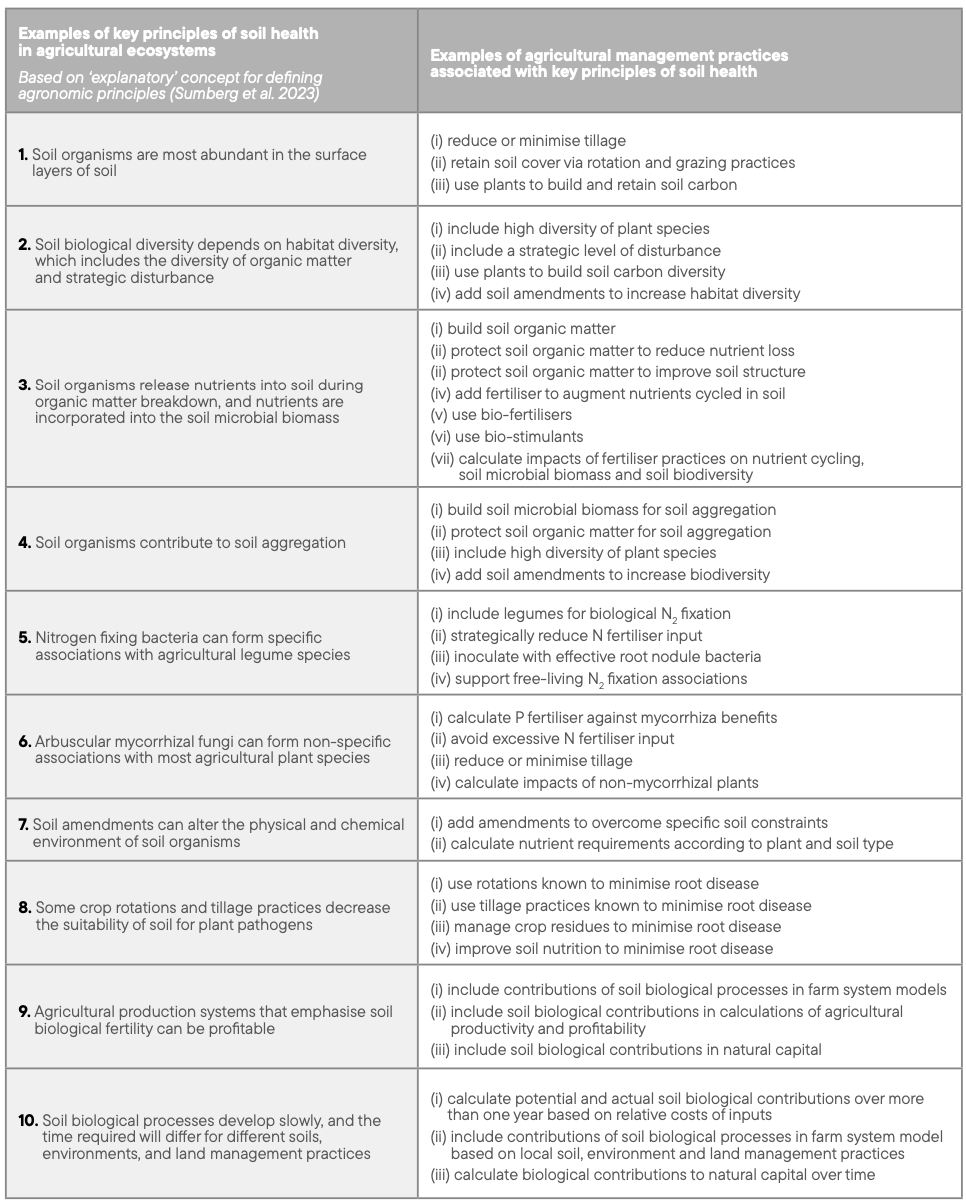
Depending on local conditions and farming systems, some management practices will obviously have greater impacts on components of soil health than others. Addressing soil health principles facilitates a focus on core soil conditions required for long-term soil security while acknowledging marked variability across soil types, landscapes, environmental conditions, and farming systems. This analysis also addresses the potential resilience of farming systems to climate change.
Principles of soil health
Soil is extremely complex, so it is presumptive to limit the number of soil health principles to ten as listed below. Furthermore, the framework of soil health principles chosen here highlights a biological perspective of soil health. There is a reason for this. The examples of key principles of soil health begin with a focus on soil organisms because the health of soil is fundamentally linked to biological processes, as is the case for the health of other systems, including natural ecosystems, animal communities and human communities.
Examples of key principles of soil health in agricultural ecosystems
Soil Health Principle 1. Soil organisms are most abundant in the surface layers of soil
All soils contain living organisms and their abundance and diversity differs with location, environment, soil type and other soil characteristics. Soil organisms have key roles in development of soil structure via aggregation of soil particles, water provision to plants (including soil wettability), nutrient supply for plants (including biological transformation of nutrients), and through close affiliation with roots. Although soil organisms occur throughout the soil profile, their relatively high abundance in surface soil layers occurs because that is where most organic matter and roots reside, and hence provide the sources of energy and carbon for the majority of soil organisms. Consequently, it is essential to protect surface soil layers to strengthen the opportunities for soil organisms to contribute to soil health and associated ecosystem services.
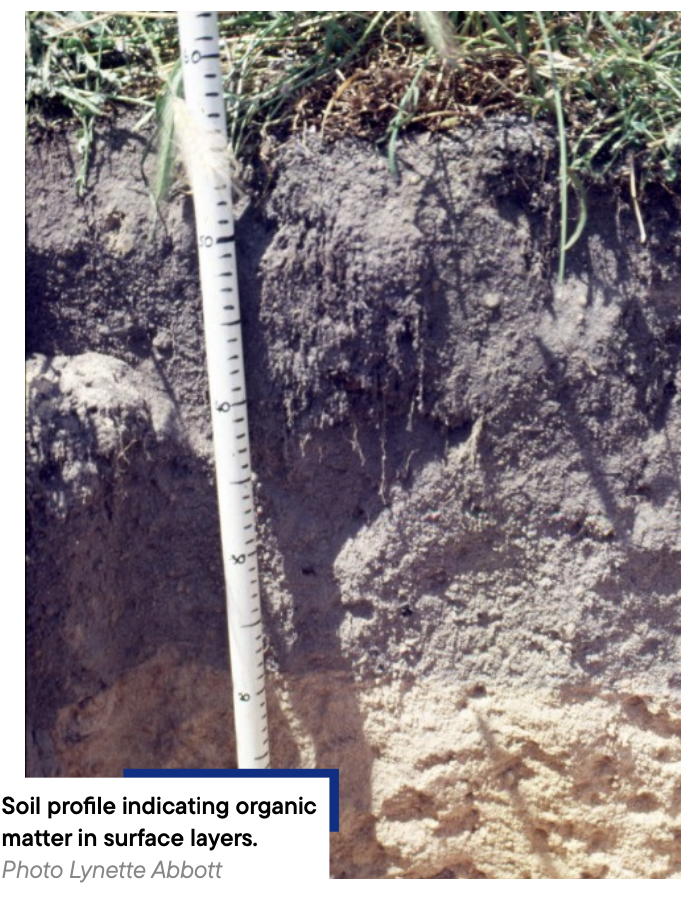
Examples of agricultural management practices
- (i) Reduce or minimise tillage:
- When soil is disturbed, as occurs during tillage to reduce weeds or for provision of a suitable seed bed, organic matter is also disturbed and more of it is exposed to soil organisms, leading to a loss of soil carbon via mineralisation and a loss of nutrients via wind or water erosion.
- (ii) Retain soil cover via rotation and grazing practices:
- When the soil surface is well covered by plant matter, as living plants, stubble or other plant residues, it is protected from wind and water erosion. Loss of plant cover via heavy grazing by animals can also lead to considerable loss of surface soil.
- (iii) Use plants to build and retain soil carbon:
- Plants play a significant role in both building and retaining soil carbon. The maintenance of a diversity of plant species as grassland or intercropping, or by rotation of crops, enables greater exploration of the soil by roots and facilitates aggregation of soil particles in conjunction with soil organisms. Soil aggregation protects soil carbon and minimises soil loss.
Soil Health Principle 2. Soil biological diversity depends on habitat diversity, which includes the diversity of organic matter and strategic disturbance
The greater the complexity of the soil environment, the greater the range of habitats available to soil organisms. The bulk of soil organic matter is derived from plants which can have different structures and this contributes to habitat diversity. Consequently, the diversity of bacteria, archaea, fungi and soil fauna is greater when there are more protected niches for communities to explore and congregate. The habitat of soil organisms is created and changed according to the inherent soil type (e.g. its structure and mineral composition), the chemical composition and physical form of soil organic matter, the actions of other soil organisms (e.g. earthworms) and the growth and persistence of roots. Soil aggregates are formed by interactions between soil particles, organic matter and some soil organisms. This creates soil pores, to different extents, depending on the soil type and environment. Small and large soil animals influence soil aggregation both directly and indirectly through interactions with organic matter and microorganisms and further change the soil environment for other organisms. Soil disturbances (e.g. by agricultural practices) also influence the soil habitat and alter nutrient availability and water transfer via soil pores.
Examples of agricultural management practices:
- (i) Include high diversity of plant species:
- The inclusion of a diversity of plant species in farming systems creates a diverse habitat for a wide range of soil organisms which make contributions to soil health. Diversity of plant species has potential to build resilient communities of soil organisms that have important roles in nutrient uptake by plants and minimise the potential for dominance of root pathogens.
- (ii) Include a strategic level of disturbance:
- Strategic soil disturbance using practices such as reduced tillage has potential to aerate soil and prevent compaction. Lack of aeration and soil compaction can both inhibit activities of soil organisms and minimise their contribution to soil health. Strategic soil disturbance can also be introduced by growing a variety of plant species with different root architectures so that the soil is exposed to minor disturbances that enable water and airflow and reduce compaction. Deep-rooted plant species for example provide important benefits beyond the upper soil layers.
- (iii) Use plants to build soil carbon diversity:
- Plants have different chemical structures and therefore provide different kinds of habitats for soil organisms. Organic matter in soil originates primarily from plants and is colonised by communities of soil organisms during its incorporation into soil organic matter fractions. Some plants contribute to retaining more soil carbon than others depending on their molecular configuration, interactions with soil communities, requirements for nutrients, and responses to soil disturbances.
- (iv) Add soil amendments to increase habitat diversity:
- A wide range of soil amendments is used in agriculture (apart from fertilisers), including lime, gypsum, clay, humates, and biological resources such as biochar, compost, biosolids and manure etc. These soil amendments are used in agriculture for many different reasons, but they all have the potential to change the soil as a habitat for living organisms, as well as contribute in other ways such as altering soil pH, improving the structure of sandy soil, or providing nutrients from recycled waste materials. Examples of changes to the soil habitat include making parts of the soil matrix more conducive for microbial growth by adding compost, or improving the chance for root nodule bacteria to form a symbiosis with legumes by adding lime.
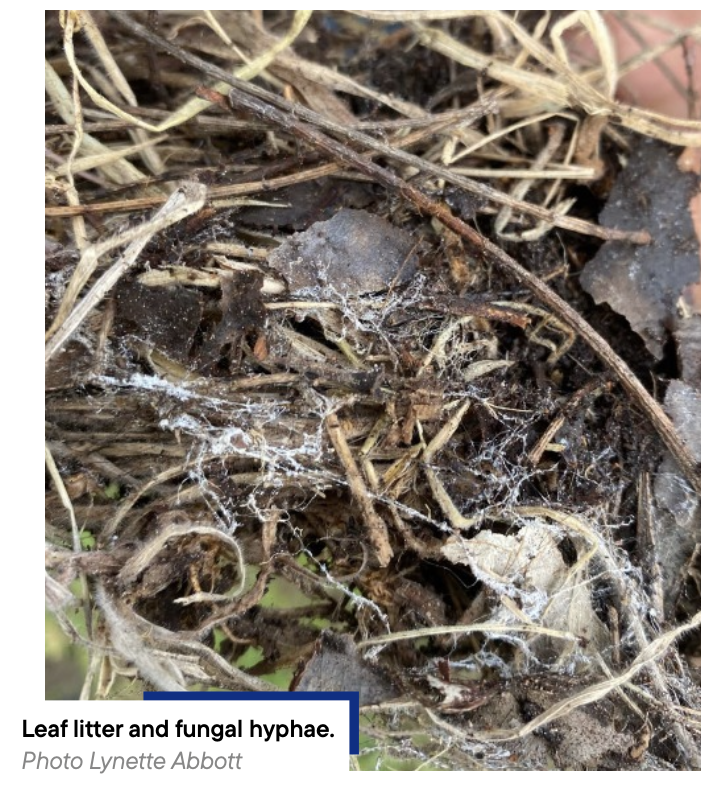
Soil Health Principle 3. Soil organisms release nutrients into soil during organic matter breakdown, and nutrients are incorporated into the soil microbial biomass
The process of decomposition of organic material in soil is called mineralisation. During mineralisation, elements that were part of the structure of carbon-based molecules are oxidised into less complex forms. They may at first be combined with other organic molecules but are eventually transformed into inorganic molecules. For example, nitrogen is present in organic molecules such as protein. When protein is degraded, nitrogen is eventually released as ammonium ions, which is an inorganic form of nitrogen. As carbon is released during mineralisation, other elements also become available. This provides both plants and soil organisms with a range of nutrients including phosphorus, sulphur, nitrogen and other elements.
A complementary process to mineralisation is immobilisation which is the accumulation of nutrients within the cells of soil organisms making them temporarily unavailable to plants. When organic matter is decomposed, nutrients in the soil are taken into the cells of soil organisms and accumulate in the soil microbial biomass which is an important carbon and nutrient pool.
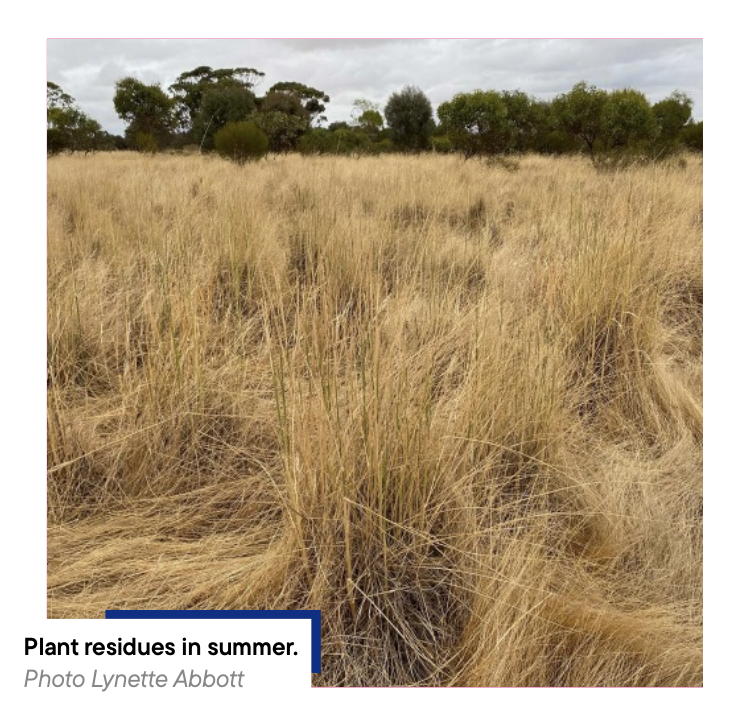
Examples of agricultural management practices
- (i) Build soil organic matter:
- Agricultural practices that return high levels of plant organic matter to the soil are essential for providing an energy and carbon source for the majority of the living soil community. Although some soil microorganisms do not gain their carbon directly from decaying organic material, they are usually indirectly affected by those which do – this includes mycorrhizal fungi which access carbon directly from roots and nitrifying bacteria which access carbon from CO2.
- (ii) Protect soil organic matter to reduce nutrient loss:
- High levels of soil disturbance can lead to loss of soil organic matter and nutrients. Therefore, practices such as reduced tillage and growth of plants with extensive root systems contribute to protection of these essential attributes. It is a natural process for soil organic matter to be degraded by soil organisms. If most of the organic matter in soil is degraded quickly (and hence lost), there is a chance that nutrients required by plants will also be lost.
- (iii) Protect soil organic matter to improve soil structure:
- Practices that protect soil organic matter also have other benefits such as improving soil structure. Better soil structure assists growth of roots and fungal hyphae, and physically protects soil organic matter within the soil matrix for soil carbon sequestration.
- (iv) Add fertiliser to augment nutrients cycled in soil:
- Agricultural production results in removal of nutrients in produce – as grain, fruit, root crops etc. Therefore, there is a constant need to replace nutrients. For some soils, high levels of plant-available nutrients occur naturally, so nutrient depletion via produce removal off farm will represent a lower proportion of nutrients than in soils which are highly weathered or eroded. Given the capacity of soil organisms to cycle nutrients in soil, their potential to do this can be included when calculating fertiliser inputs. If the potential for nutrient cycling by soil organisms is not considered in fertiliser decision-making programs, there is a risk that more fertiliser will be used than is necessary leading to inefficiency in fertiliser use.
- (v) Use bio-fertilisers:
- Bio-fertilisers, whether purchased or produced on-farm, may use carbon-based waste resources. They may have slow-release nutrient properties compared with more soluble manufactured chemical fertilisers. Combining bio-fertilisers with chemical fertilisers may be an effective mode of nutrient delivery, depending on the farming system.
- (vi) Use bio-stimulants:
- Bio-stimulants include products that may stimulate plant growth by increasing the efficiency of nutrient uptake by plants, or by increasing root growth and enabling greater exploration of soil for nutrient acquisition by plants. As for bio-fertilisers, they may be purchased or produced on-farm. Bio-stimulants may increase the efficiency of fertiliser use, and reduce nutrient loss by enabling a reduction in fertiliser application rates.
- (vii) Calculate impacts of fertiliser practices on nutrient cycling, soil microbial biomass and soil biodiversity:
- The reason for linking this agricultural practice to Soil Health Principle 3 that “soil organisms release nutrients into soil during organic matter breakdown, and nutrients are incorporated into the soil microbial biomass” is that: some fertiliser practices can impact natural soil nutrient cycling processes (leading to inefficiency of nutrient use), some fertiliser practices may lead to reductions in the microbial biomass in soil (reducing the retention of nutrients and carbon in an important storage pool), and some fertiliser practices may alter the diversity of plant species (e.g. in grasslands), reducing soil habitat diversity and altering soil biodiversity and function.
Soil Health Principle 4. Soil organisms contribute to soil aggregation
Soil particles may strongly or more weakly adhere to each other in combination with organic matter and the activities of soil microorganisms, such as production of gums or networks of fungal hyphae. Aggregate sizes vary with soil type and are affected by management history.
Soil aggregates contribute to the development of the important pore structure in soil which provides aeration and water flow at a fine scale within the soil matrix. Roots are also commonly associated with soil aggregates which can protect rhizosphere communities from predation.
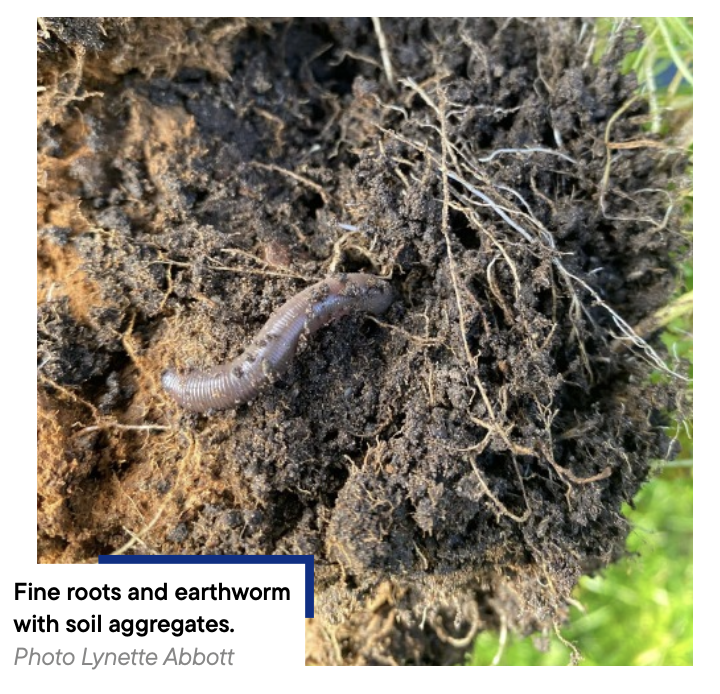
Examples of agricultural management practices
- (i) Build soil microbial biomass for soil aggregation:
- Agricultural practices associated with the first three principles mentioned above also contribute to aggregation of soil particles and subsequent protection of some of the soil microbial biomass. This mass of organisms may be relatively inactive when present within aggregates, but they are protected and may become active members of the soil community at a later time. Aggregates provide valuable reservoirs of soil organisms at times when soil conditions are constrained by drought, high or low temperatures or environmental contamination.
- (ii) Protect soil organic matter for soil aggregation:
- As interactions between soil organisms and organic matter are crucial for formation of stable aggregates, the practices mentioned above related to the preservation of soil organic carbon are equally important for soil structure.
- (iii) Include high diversity of plant species:
- Farming systems that include high diversities of plant species have greatest potential to build resilient soil communities and soil carbon. This includes building soil carbon at depth with deep rooting plants, reducing the potential for soil erosion, and securing soil during severe weather events including periods of drought.
- (iv) Add soil amendments to increase biodiversity:
- The addition of soil amendments such as clay to very sandy soil can improve soil structure and overcome water repellence. Application of gypsum can improve soil structure. Soil amendments such as biochar contribute habitat niches, enhancing soil biodiversity benefits that contribute to provision of important ecosystem services.
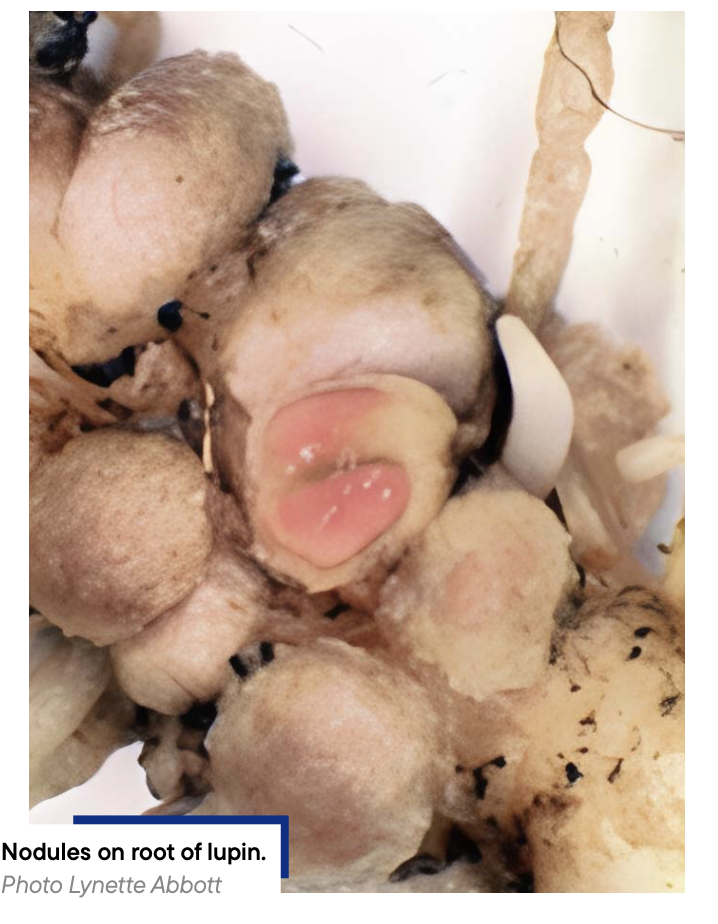
Soil Health Principle 5. Nitrogen fixing bacteria form can form specific associations with agricultural legume species
Biological nitrogen fixation can make a very valuable contribution to farming systems by converting atmospheric nitrogen to plant-available nitrogen and reducing the need for nitrogen fertiliser. Symbiotic nitrogen fixing bacteria form associations with legumes to meet their nitrogen needs, and in addition have potential to contribute significant quantities of nitrogen to subsequent crops and grasslands as their plant matter degrades, reducing subsequent use of nitrogen fertiliser. In addition, some free-living nitrogen-fixing microorganisms can fix atmospheric nitrogen in loose association with roots, making an important contribution to plant nutrition.
Examples of agricultural management practices
- (i) Include legumes for biological N2 fixation:
- The very well understood contributions of symbiotic nitrogen fixation in association with agricultural legumes makes them important plants in farming systems. As well as providing a source of nitrogen that is readily available on-farm, legumes commonly have a higher concentration of nitrogen in their tissues, so when they degrade after their productive period, they contribute significant quantities of nitrogen to soil for subsequent crops.
- (ii) Strategically reduce N fertiliser input:
- If high levels of nitrogen fertiliser are used with legumes, the process of biological nitrogen fixation is inhibited. Therefore, in order to ensure legumes contribute to their own nitrogen nutrition, fertiliser nitrogen use needs to be reduced.
- (iii) Inoculate with effective root nodule bacteria:
- The association between legumes and nitrogen fixing bacteria is highly specific, and the required bacteria for many agricultural legumes may not be present in agricultural soils if the legumes have been sourced elsewhere, including from other countries. So inoculation with the appropriate root nodule bacteria is necessary if they are commercially available. Considerable research has been conducted to identify the most effective nitrogen fixing bacteria for each legume, and the characteristics which enable the bacteria to survive in soil prior to formation of the root nodule where they fix atmospheric the nitrogen may also need to be taken into account.
- (iv) Support free-living N2 fixation associations:
- While free-living nitrogen fixing microorganisms commonly occur in agricultural soils the quantities of atmospheric nitrogen they fix and convert to plant available nitrogen are difficult to predict. These soil organisms have potential to make significant contributions to soil nitrogen, especially in farming systems that include grasslands.
Soil Health Principle 6. Arbuscular mycorrhizal fungi can form non-specific associations with most agricultural plant species (Click here to read)
Arbuscular mycorrhizas are common associations between plants and highly specialised fungi that participate in important soil health processes. This can include increasing plant use efficiency of nutrients, especially phosphorus, from fertilisers, during the breakdown of soil organic matter, and from soil minerals. Arbuscular mycorrhizal fungi form extensive networks of hyphae in soil that extend around roots and increase the volume of soil that can be explored. In addition to nutrient scavenging, the hyphae contribute to maintenance of a friable soil structure that benefits root growth, and even helps plants access water in tiny soil pores when soil conditions are dry. Mycorrhizas may also contribute to protection against root disease.
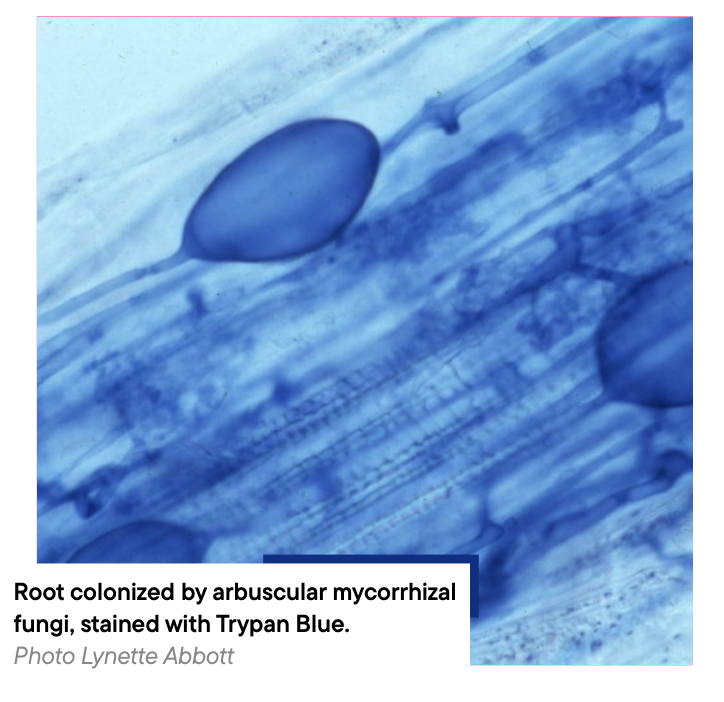
Examples of agricultural management practices
- (i) Calculate P fertiliser against mycorrhiza benefits:
- High rates of application of phosphate fertiliser can reduce the extent to which roots are colonised by arbuscular mycorrhizal fungi, and hence discount some of their potential benefits. Because these fungi can increase the efficiency of uptake of phosphorus from soil, and their hyphae can contribute to soil aggregation processes, their potential contributions in all agricultural soils should be taken into account when selecting the amount of phosphate fertiliser applied.
- (ii) Avoid excessive N fertiliser input:
- High rates of nitrogen fertiliser can increase root growth excessively and reduce the extent of root colonisation by arbuscular mycorrhizal fungi. This can occur if the rate of root growth is greater than the rate of colonisation of the roots by the fungi, effectively leading to a dilution effect with a greater amount of root compared to the fungi.
- (iii) Reduce or minimise tillage:
- Excessive soil disturbance can interfere with colonisation of roots by arbuscular mycorrhizal fungi by disrupting hyphal networks in the soil.
- (iv) Calculate impacts of non-mycorrhizal plants:
- Some agricultural plant species, such as brassicas, do not form arbuscular mycorrhizas. Therefore, their inclusion in rotations can deplete communities of arbuscular mycorrhizal fungi over time. These symbiotic communities can be restored using plant species that have extensive root systems, including grasses.
Soil Health Principle 7. Soil amendments can alter the physical and chemical environment of soil organisms
A wide range of soil amendments, in addition to fertilisers, include microbial bio-stimulants and non-living biological resources such as humates and biochar. Most soil amendments alter physical and chemical attributes of the soil environment in various ways, and influence soil communities. For example, lime alters soil pH, and composted material can provide a source of carbon for some organisms and increase water retention in soil, leading to changes in both chemical and physical characteristics of the soil environment, as well as modifying the structure of soil communities.
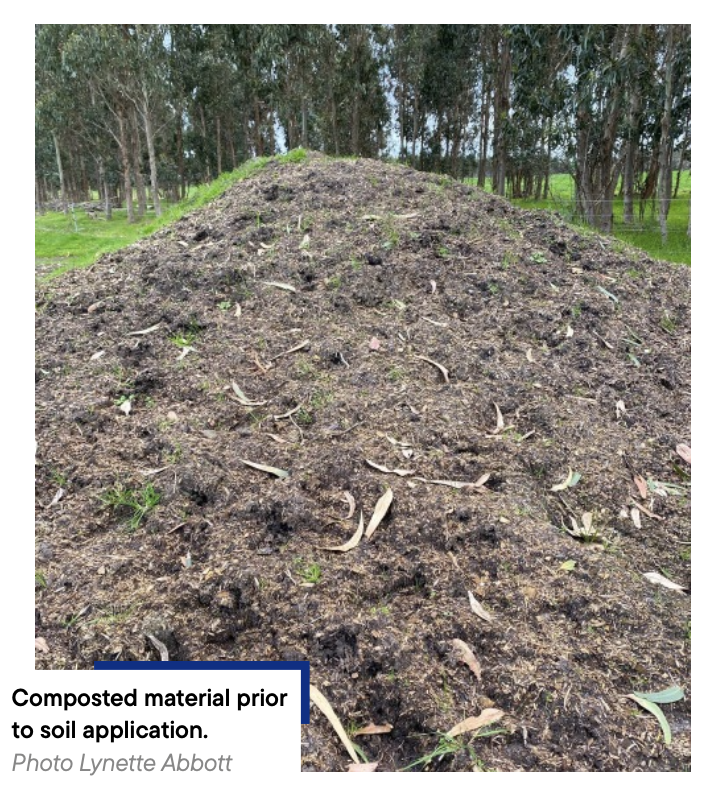
Examples of agricultural management practices
- (i) Add amendments to overcome specific soil constraints:
- While various amendments are used to overcome soil constraints which hamper plant production, they simultaneously alter the conditions of soil organisms. This may positively influence soil biodiversity, and contribute to beneficial soil biological processes which have complementary benefits to alleviating other soil constraints to plant production.
- (ii) Calculate nutrient requirements according to plant and soil types:
- There is already considerable knowledge available for calculating fertiliser requirements for plants according to cultivar, soil type, season, environment etc. If these fertiliser management calculations also consider impacts on soil organisms (including the possibility of diminishing or increasing contributions), there could be a valuable soil health benefit in the longer term.
Soil Health Principle 8. Some crop rotations and tillage practices decrease the suitability of soil for plant pathogens
Plant disease is the result of a complex interaction between a host plant, a pathogen and the environmental conditions, including those in soil. Soil conditions that may influence the development of disease include pH, moisture, oxygen, and nutrients. In addition, other soil organisms interact with pathogens, sometimes creating ‘suppressive’ soils where the activity of the pathogen is diminished due to the development of a particular combination of soil organisms. The extent of these interactions can also be influenced by soil conditions which affect the growth and activity of the non- pathogenic organisms. Consequently, whenever the soil environment changes, there is potential for either a positive or negative influence on soil-borne plant pathogens.
Examples of agricultural management practices
- (i) Use rotations known to minimise root disease:
- As root pathogens are usually host specific, minimising the presence of the host plant within the farming system for a period of time can reduce dominance of the pathogen and reduce the likelihood of disease.
- (ii) Use tillage practices known to minimise root disease:
- Soil disturbance can disrupt the life cycle of some pathogens.
- (iii) Manage crop residues to minimise root disease:
- Some pathogens are carried over on crop residues, so careful management of diseased plant residues is necessary to eliminate the disease threat for future crops or pastures.
- (iv) Improve soil nutrition to minimise root disease:
- Plants that suffer from nutrient deficiency can sometimes be less resilient to attack by pathogens in soil. Therefore, avoidance of nutrient deficiency may protect plants against some diseases.
Soil Health Principle 9. Agricultural production systems that emphasise soil biological fertility can be profitable
The real cost of agricultural production does not usually take into account factors such as soil loss through wind or water erosion, or the loss of nutrients applied as fertiliser in excess of plant requirements. The failure to capture potential benefits from soil organisms due to implementation of practices that do not enable them to contribute, may be a less obvious but significant cost against profitability.
Examples of agricultural management practices
- (i) Include contributions of soil biological processes in farm system models:
- If the contributions of soil biological processes are included in farm system models up-front, even as simulations, there would be greater potential to acknowledge them as integral contributors to soil health.
- (ii) Include soil biological contributions in calculations of agricultural productivity and profitability:
- Where possible, contributions of soil biological processes at a paddock or farm scale should be calculated or estimated. This includes estimates of biological nitrogen fixation and root disease load. Estimates of soil biological contributions should be determined over several years, rather than a single growing season, with a farming system focus.
- (iii) Include soil biological contributions in natural capital:
- While soil is generally included as part of the natural capital of agricultural land, the data collected may not address the full value of the state of the soil unless it includes the potential of the living components of the soil to sustain ongoing productivity.

Soil Health Principle 10. Soil biological processes develop slowly, and the time required will differ for different soils, environments and land management practices
A greater reliance on nutrient cycling by soil organisms in agricultural production systems may initially result in a higher degree of variability in productivity. However, co-benefits related to improvements in all components of soil and environmental health are a bonus, and over time have potential to stabilise the farming system with an underlying resilience facilitated by a wide variety of activities of soil organisms. Soil biological processes take time to develop and contribute, and can easily be hampered by inappropriate practices. Therefore, unlike production systems based primarily on reliable fertiliser practices that overlook soil biological components of soil health, a greater focus on how soil organisms can contribute within farming systems has potential to achieve greater resilience to climate change and soil security in the long-term.
Examples of agricultural management practices for Soil Health Principle 10 are: calculate potential and actual soil biological contributions over more than one year based on relative costs of inputs; include contributions of soil biological processes in a farm system model based on local soil, environment and land management practices; and calculate soil biological contributions to natural capital over time.
- Sumberg J, Giller KE and Glover D (2023) Evolving meanings of ‘principles’ in agronomic discourse. Outlook on Agriculture Vol. 52(4) 363–370. DOI: 10.1177/00307270231213659

